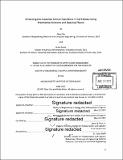Enhancing the customer service experience in call centers using preemptive solutions and queuing theory
Author(s)
Chu, Qiao, M. Eng. Massachusetts Institute of Technology; Palvia, Nisha
DownloadFull printable version (12.11Mb)
Other Contributors
Massachusetts Institute of Technology. Supply Chain Management Program.
Advisor
James B. Rice, Jr.
Terms of use
Metadata
Show full item recordAbstract
The security alarms services market in the United States delivers hardware equipment and services to homeowners and businesses to help monitor and enhance personal property protection. Customer satisfaction via wait time reduction, first call resolution, and cost minimization are key drivers of success to players in this market. Most companies invest heavily in customer service systems including call centers. Our client, AlarmCo, a top provider of property protection, manages an inbound call center that supports a range of questions from customers who call within thirty days from the alarm installation date. Often, security companies fail to utilize strategic solutions when managing inbound customer call traffic and default to reactive measures which unnecessarily increase customer wait times. The key question the team aims to address in this thesis is: "How can we improve the customer service experience for customers of a major security service provider in the United States?" For this thesis, MIT partnered with OnProcess Technology, a managed services provider specializing in complex, global service supply chain operations, to develop a robust framework to preemptively reduce the number of inbound customer calls, and thereby improve customer service. Using ABC segmentation, the team categorized customers by reason code and demographics. To simulate the client's call center queue, the team calculated the key inputs for the queuing model including average wait time, interarrival rates and number of servers. The team then chose and developed the M/M/n stochastic queuing model for the simulation. The M/M/n queue reflects a simple system with parallel servers, arrivals with a Poisson distribution and service times that are exponentially distributed. Next, the customer segmentation was used to develop targeted preemptive solutions. Taking into account feasibility ratings, the team assigned success rates to each solution and adjusted the inbound call data accordingly. By analyzing the outputs of the simulation before and after adjusting the dataset, the team quantified the impact of preemptive solutions on the call center queue. Ultimately, narrowing to twelve strategic preemptive solutions led to the enhancement of the as-is queuing model by reducing average wait time by up to 35%.
Description
Thesis: M. Eng. in Supply Chain Management, Massachusetts Institute of Technology, Supply Chain Management Program, 2017. Cataloged from PDF version of thesis. Includes bibliographical references (page 79).
Date issued
2017Department
Massachusetts Institute of Technology. Supply Chain Management ProgramPublisher
Massachusetts Institute of Technology
Keywords
Supply Chain Management Program.